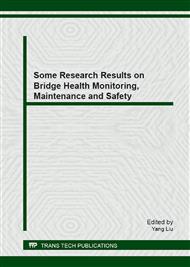p.1
p.11
p.21
p.29
p.37
p.47
p.55
p.63
Analysis of Traveling Wave Effect on Half-Through CFST Arch Bridge by Large Mass Method
Abstract:
For long span arch bridges, the traveling wave effect is an important aspect on seismic response of structure which cannot ignore. The Big Mass Method was used to analyze the seismic response of a half-through CFST arch bridge under both uniform and non-uniform excitations. The results showed that the traveling wave effect caused by non-uniform excitation led to more obvious seismic response in both internal forces and displacements. The skewback section was most dangerous. The waveform of internal forces caused by non-uniform excitation was quite similar to that caused by uniform excitation, but the amplitude of the latter is bigger than the former. It can conclude that the traveling wave effect would cause the unsynchronized vibration to the structure elements which led to the lager responses.
Info:
Periodical:
Pages:
21-28
Citation:
Online since:
January 2013
Price:
Сopyright:
© 2013 Trans Tech Publications Ltd. All Rights Reserved
Share:
Citation:


